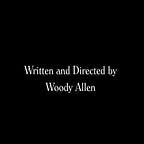Gordon Willis & Woody Allen: A Masterclass in Cinematography
Gordon Willis, affectionately dubbed “The Prince of Darkness” for his innovative use of shadow in film, significantly shaped the cinematic world. His collaboration with Woody Allen across eight films, from “Annie Hall” in 1977 to “The Purple Rose of Cairo” in 1985, represents a distinctive chapter in the annals of filmmaking. Let’s get into the heart of Willis’s cinematographic artistry and its impact on Allen’s films, exploring the seamless blend of directorial vision and cinematographic craft.
Willis’s approach to cinematography was distinguished by a profound dedication to lighting and composition. He held a belief that shadows could speak volumes, sometimes even more eloquently than light. This philosophy vividly came to life in his work with Allen, where shadows were not mere background elements but key players in setting the mood, adding depth, and revealing the complexities of characters. In “Annie Hall”, Willis’s naturalistic lighting style beautifully complemented Allen’s storytelling, giving the film an authentic texture that resonated with the realness of the characters’ emotions and experiences.
Their collaboration soared with “Manhattan” in 1979. Filmed in black and white, this movie stands as a tribute to Willis’s mastery over the interplay of light and dark. The film’s memorable opening montage, set against George Gershwin’s “Rhapsody in Blue”, showcases cinematography as an art form capable of transcending traditional visual storytelling. Willis’s framing and use of contrast imbued the New York Cityscape with a romantic, almost ethereal quality, perfectly mirroring the film’s exploration of love and human relationships.
“Interiors” in 1978 showcased Willis’s unique ability to use cinematography as a window into the characters’ minds. The film’s restrained color palette and deliberate composition mirrored the inner turmoil of its characters. Willis’s use of space and light in “Interiors” spoke volumes about the characters’ internal struggles, all without relying heavily on dialogue.
In “Stardust Memories” from 1980, Willis and Allen drew inspiration from the iconic Federico Fellini’s “8½". Here, Willis’s cinematography was both a nod to Fellini and a showcase of his own creative range. The film’s dynamic camera movements and innovative lighting added layers of complexity to its narrative structure.
“The Purple Rose of Cairo” in 1985 marked the final act in Willis and Allen’s creative partnership. Willis’s cinematography was pivotal in differentiating the real world from the fictional film-within-the-film. His subtle shifts in lighting and tone not only distinguished these two realms but also deepened the film’s exploration of fantasy versus reality.
The films Willis and Allen created together are more than just cinematic accomplishments; they represent a rich dialogue between two artists at their creative zenith. Willis’s cinematography didn’t just serve Allen’s directorial vision; it broadened and enriched it. His innovative use of light and shadow brought a depth and texture to these films, elevating them from simple stories to works of cinematic art.
In essence, Gordon Willis’s contribution to his films with Woody Allen is monumental. His cinematography went beyond creating visually stunning images; it was about using light, shadow, and composition to weave a story, evoke emotions, and create an immersive atmosphere. Willis’s work on these films remains a standard in the art of cinematography and a powerful testament to the art of visual storytelling in cinema.
